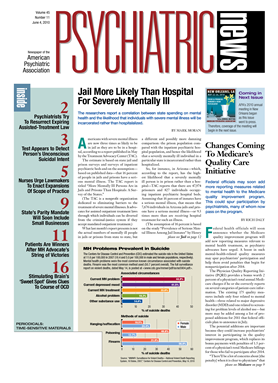People with serious mental illness are accounting for an ever-increasing share of those behind jail and prison bars, but new data show that a number of characteristics appear to differentiate those most at risk of being arrested and incarcerated for misdemeanors from those more apt to face and be imprisoned for felony charges.
For those who have already had contact with the criminal justice system, “being male, being homeless, having an involuntary psychiatric evaluation, and not having mental health treatment in the previous quarter independently increased the odds” of both being rearrested for a misdemeanor and spending additional days in jail, according to a report in the May Psychiatric Services.
The factors that increased the risks that inmates with a serious mental illness would be rearrested and charged with a felony were not, however, the same ones that demonstrated strong links to misdemeanor arrests. In this case, being black, being younger, having received a psychiatric diagnosis other than psychosis, and having a comorbid substance abuse disorder all independently increased the odds that someone with a previous arrest would be rearrested for a felony crime.
The study was conducted by Robert Constantine, Ph.D., M.P.H., and colleagues from the Florida Mental Health Institute at the University of South Florida.
Constantine and colleagues noted that having undergone an involuntary psychiatric evaluation and failing to receive mental health care in the preceding quarter were also linked with felony arrests, as they were with misdemeanor arrests, but the relationship was much weaker in those charged with felonies.
They hypothesized that the strong link between homelessness and misdemeanor arrests, a relationship that did not exist for felonies, was due to homeless individuals frequently committing “survival crimes like petty theft or shoplifting” and “nuisance crimes” such as disorderly conduct and public intoxication in locations where they are often seen by police who then respond by arresting them.
The researchers did not draw conclusions about the strong link between being black and being arrested for felonies but not misdemeanors, noting that the link could be related to specific behaviors that differ between blacks and those of other races “or differences in how law enforcement responds to the same or similar behavior exhibited by blacks and nonblacks.”
The key message the researchers want to get out based on their study is that arrestees and their complex needs should not be viewed as a one-size-fits-all population as far as preventive and follow-up services are concerned. These individuals often have very different needs. And because people arrested for misdemeanors take up an enormous amount of the judicial system's time and financial resources due to recidivism and the prevalence of these crimes, “a special focus on groups with elevated risks of misdemeanor but not felony arrests and [risk] of additional days in jail could help policymakers reduce the pressure on local criminal justice and judicial systems and facilitate the recovery of the consumers involved.”
The study population was identified through the Pinellas County, Fla., criminal justice information database. The researchers identified all adults aged 18 to 64 who were in the county jail from July 1, 2003, to June 30, 2004. They then searched all available “event data sets” that indicated that an arrestee had received mental health services in Pinellas County and gotten “a serious mental illness diagnosis” any time from July 2002 to June 2006. After the cohort was identified, future arrests were identified through the Florida Department of Law Enforcement's statewide database.
Constantine and colleagues acknowledged limitations of their study, including that the focus was only on one county and that criminal-justice and mental health service systems vary considerably across the nation. In addition, the diagnoses that became part of their analysis were not verified, and services that subjects might have received in the private mental health sector were not part of the data.

